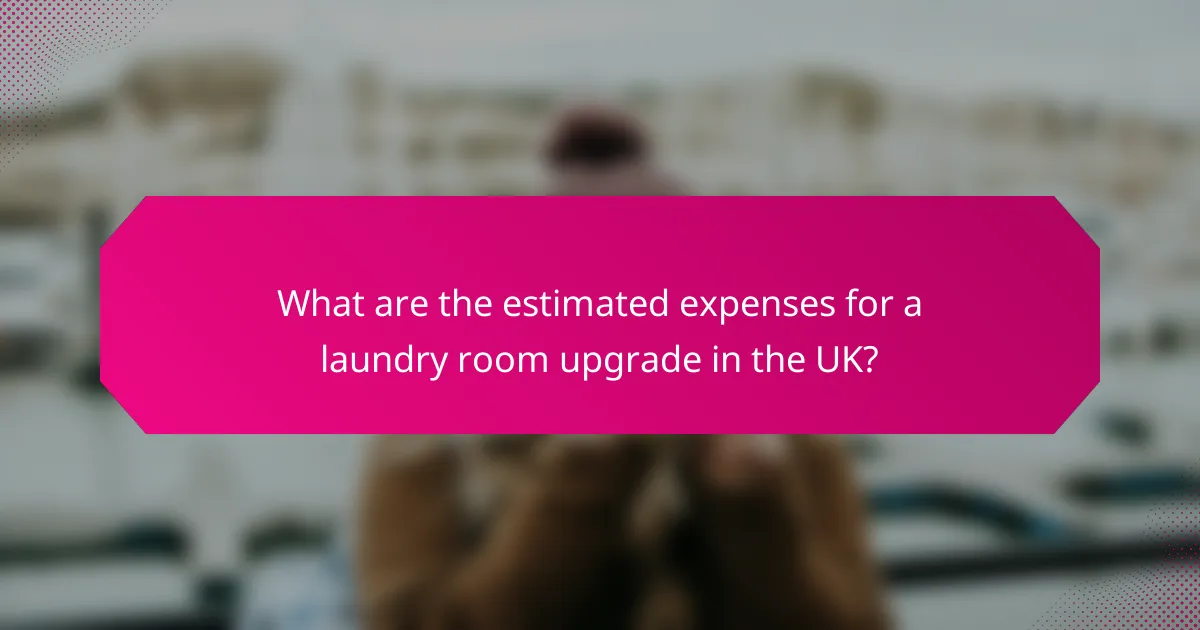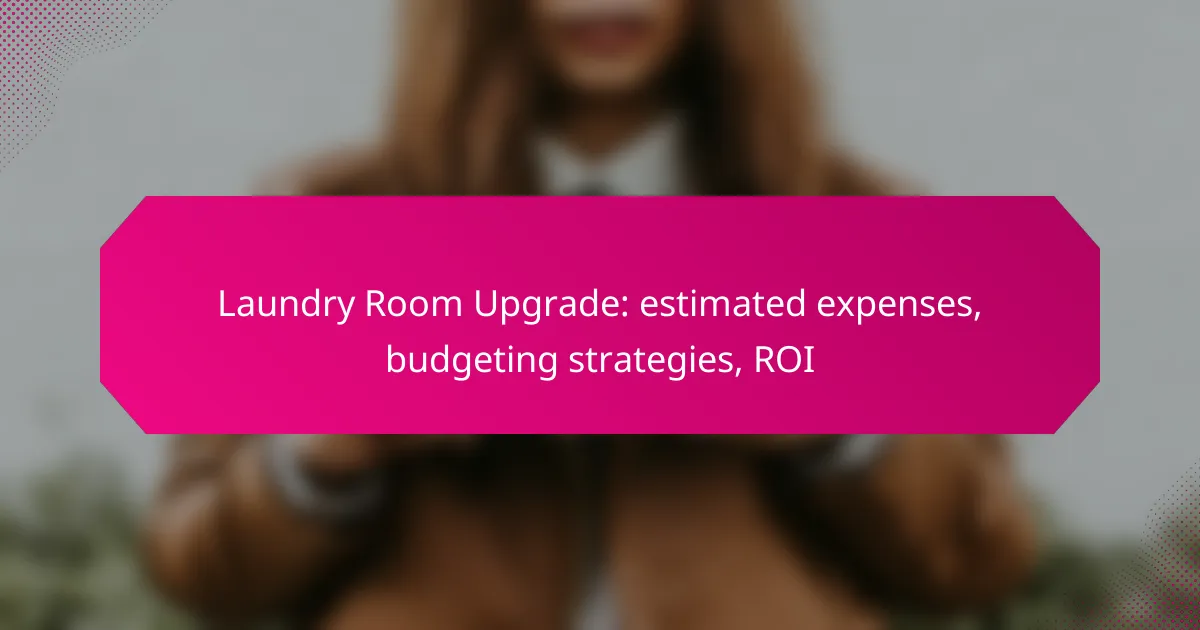Upgrading your laundry room can be a rewarding investment, with estimated expenses in the UK ranging from a few hundred to several thousand pounds depending on the project’s scope. Careful budgeting is essential, as costs for appliances, materials, and installation can add up quickly. By assessing your current space and planning accordingly, you can maximize your return on investment, which typically falls between 60% and 80% when selling your home.

What are the estimated expenses for a laundry room upgrade in the UK?
The estimated expenses for a laundry room upgrade in the UK can vary significantly based on the scope of the project, ranging from a few hundred to several thousand pounds. Key costs include appliances, materials, installation, and potential permits, all of which should be carefully budgeted to avoid surprises.
Average costs for appliances
When upgrading appliances, expect to spend between £300 to £1,500 for a washing machine and around £200 to £1,000 for a dryer, depending on the brand and features. Energy-efficient models may have a higher upfront cost but can save money on utility bills over time.
Consider additional appliances like washer-dryer combos or steamers, which can range from £400 to £1,200. Prioritize appliances that fit your laundry habits and space constraints.
Renovation material expenses
Material costs for a laundry room upgrade typically range from £500 to £2,000, depending on the quality and type of materials chosen. Common materials include cabinetry, countertops, flooring, and wall finishes, which can significantly impact the overall aesthetic and functionality.
For instance, laminate countertops are more budget-friendly, while quartz or granite can elevate the space but at a higher cost. Always factor in the durability and maintenance of materials when making selections.
Installation and labor costs
Installation and labor costs can add an additional £300 to £1,500 to your total budget. Hiring professionals for plumbing, electrical work, and cabinetry installation ensures compliance with regulations and quality workmanship.
Consider obtaining multiple quotes from contractors to find competitive rates. If you have DIY skills, tackling some tasks yourself can help reduce these costs.
Permitting and inspection fees
Permitting and inspection fees in the UK can vary based on local regulations but generally range from £50 to £300. These fees may apply if you are making significant structural changes or electrical upgrades.
Check with your local council to understand specific requirements and avoid fines or delays in your project. It’s wise to include these potential costs in your overall budget from the start.
Unexpected expenses to consider
Unexpected expenses can arise during a laundry room upgrade, often ranging from £100 to £500 or more. Common surprises include plumbing issues, electrical upgrades, or hidden damage behind walls that may require immediate attention.
To mitigate these risks, set aside a contingency fund of about 10-20% of your total budget. This buffer can help you manage unforeseen costs without derailing your project.

How can I budget for a laundry room upgrade?
To budget for a laundry room upgrade, start by assessing your current space and identifying necessary improvements. Consider both the costs of materials and labor, as well as your financial capacity to ensure a smooth renovation process.
Creating a detailed budget plan
Begin by listing all potential expenses associated with the upgrade, including appliances, cabinetry, flooring, and plumbing. Research average costs in your area to create a realistic estimate, which can range from a few hundred to several thousand dollars depending on the scope of the project.
Break down your budget into categories, such as materials, labor, and permits. This will help you see where your money is going and adjust as needed throughout the renovation process.
Prioritizing essential upgrades
Focus on upgrades that will enhance functionality and efficiency, such as energy-efficient appliances or improved storage solutions. These essential improvements often provide the best return on investment (ROI) and can significantly impact your daily laundry routine.
Consider the condition of your current fixtures and appliances. If something is outdated or malfunctioning, prioritize replacing it to avoid further costs down the line.
Utilizing financing options
Explore financing options if your budget is tight. Many home improvement stores offer financing plans, and personal loans or home equity lines of credit can also be viable options. Be sure to compare interest rates and terms to find the best deal.
Look for promotional offers or zero-interest financing options that may be available for specific appliances or renovations, allowing you to spread out payments without incurring additional costs.
Setting aside a contingency fund
Allocate a portion of your budget, typically around 10-20%, for unexpected expenses that may arise during the renovation. This contingency fund can cover surprises like plumbing issues or the need for additional materials.
Having this financial buffer will help you avoid stress and ensure that your laundry room upgrade stays on track, even if unforeseen challenges occur.

What is the ROI on a laundry room upgrade?
The return on investment (ROI) for a laundry room upgrade typically ranges from 60% to 80%. This means that for every £1 spent on the renovation, homeowners can expect to recoup a significant portion of that cost when selling their home.
Average ROI percentages in the UK
In the UK, laundry room upgrades can yield an ROI of around 70% on average. This percentage can vary based on factors like location, the quality of materials used, and the overall demand for homes with modern amenities. Homeowners in urban areas may see higher returns due to increased buyer interest.
Factors influencing ROI
Several factors can influence the ROI of a laundry room upgrade. The quality of the renovation, including appliances, cabinetry, and flooring, plays a crucial role. Additionally, the size of the laundry room and its integration with the overall home design can affect buyer appeal.
Market trends also impact ROI; in areas where energy-efficient appliances are in demand, upgrades that include these features may yield higher returns. Homeowners should consider local real estate trends when planning their renovations.
Comparing ROI with other home renovations
When comparing the ROI of a laundry room upgrade to other home renovations, it often ranks favorably. For instance, kitchen remodels typically offer a similar ROI, while bathroom upgrades can sometimes exceed it. However, laundry room renovations may require less investment than a full kitchen remodel, making them an attractive option for budget-conscious homeowners.
In general, minor renovations tend to provide better ROI than extensive remodels. Homeowners should weigh the costs and potential returns of each project to determine the best investment for their property.

What are the best appliances for a laundry room upgrade?
The best appliances for a laundry room upgrade focus on efficiency, capacity, and space-saving features. Selecting the right washing machines and dryers can enhance functionality while potentially increasing your home’s value.
Energy-efficient washing machines
Energy-efficient washing machines are designed to use less water and electricity, which can lead to significant savings on utility bills. Look for models with the Energy Star label, as they meet strict efficiency guidelines set by the U.S. Environmental Protection Agency.
When choosing an energy-efficient washer, consider features like load sensing, which adjusts water levels based on the size of the load, and high spin speeds that reduce drying time. These features can save you money in the long run.
High-capacity dryers
High-capacity dryers can handle larger loads, making them ideal for families or those who frequently wash bulky items like bedding. Models with moisture sensors can automatically adjust drying time, preventing over-drying and saving energy.
When selecting a dryer, consider options like steam cycles, which can reduce wrinkles and eliminate odors. Investing in a high-capacity model can improve efficiency and reduce the number of loads you need to do each week.
Space-saving washer-dryer combos
Space-saving washer-dryer combos are perfect for smaller laundry areas, combining both functions into a single unit. These appliances are designed to fit in tight spaces while still offering decent capacity and efficiency.
While they may have longer cycle times compared to separate units, they can be a practical choice for apartments or homes with limited space. Look for models that offer quick wash and dry cycles to maximize convenience.

What design trends are popular for laundry rooms in the UK?
In the UK, popular laundry room design trends focus on functionality, efficiency, and aesthetics. Homeowners are increasingly opting for spaces that blend seamlessly with the rest of the home while maximizing storage and utility.
Minimalist design elements
Minimalist design elements emphasize simplicity and functionality in laundry rooms. This approach often includes clean lines, neutral color palettes, and uncluttered spaces, creating a calming environment for chores.
To achieve a minimalist look, consider built-in cabinetry that hides appliances and laundry supplies. Using open shelving can also provide easy access to essentials while maintaining a tidy appearance.
When selecting materials, opt for durable surfaces like laminate or quartz that are easy to clean and maintain. Incorporating natural light through windows or skylights can enhance the minimalist aesthetic, making the space feel larger and more inviting.
